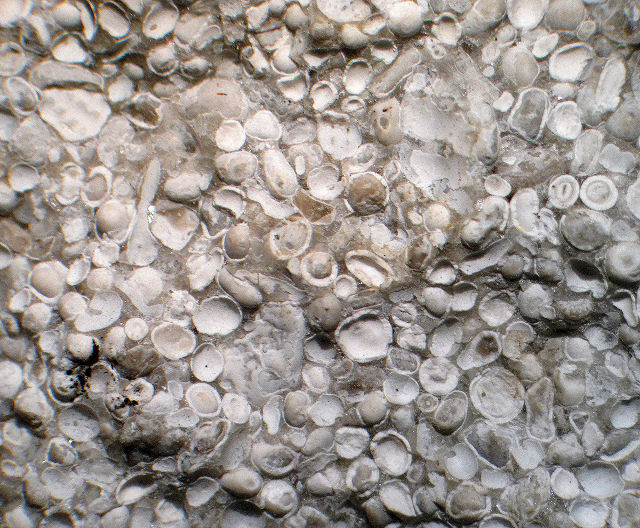Chemical and Biochemical Sedimentary Rocks
Oolitic Limestone typically forms in tidal regions where particles are in constant motion
Chemical sedimentary rock is formed when minerals, dissolved in water, begin to precipitate out of solution and deposit at the base of the water body. This can occur in hot springs, such as those in Yellowstone, where changes in water chemistry initiate precipitation of calcium carbonate in the form of travertine, or in areas where sea water evaporates, depositing rock salt or gypsum.
Due to the manner in which they are formed, these types of rocks exhibit a crystalline texture. This texture can also occur in rocks that have undergone some form of recrystallization during the lithification process. This most often occurs in rocks produced by the accumulation of siliceous or calcareous tests (or shells) of microorganisms. During the burial process, water may react within the small pores and recrystallize into fine-grained texture. Because most chemical sedimentary rocks are formed in marine environments, it is not unlikely to find fossils within chemically precipitated rocks.
In shallow marine environments a specific type of precipitation, called an ooid, can occur. In these environments material is often under constant motion due to tidal or wave action. As these materials roll back and forth on the sea floor, precipitates will crystallize on only the exposed surface. Eventually, thin spherical layers of precipitate will develop on the original particle (or nucleus). Sedimentary rocks composed of ooids are described by the precipitated mineral, for example, ooilitic limestone or ooilitic hematite.
Coquina. Form of limestone produced through the accumulation of shells
Biochemical sedimentary rocks, also known as bioclastic sedimentary rocks, form from the gradual accumulation of biologic material such as shells or dead plant material.


